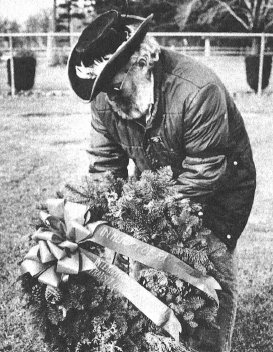Ray Phillips and the 1983 Strike
The world was a very violent place on Wednesday, Nov. 2, 1983: American troops were on the ground in Lebanon and Grenada, and U.S.-backed “contras” were fighting in Nicaragua. Al Pacino’s Scarface was filling movie theaters. That was the day that 12,700 drivers, mechanics and clerks struck Greyhound. By the time the walkout ended 47 days later, the union had been forced to accept pay cuts, health rollbacks and elimination of pensions, and striker Ray Phillips had paid the ultimate price in the name of labor solidarity.
But members of ATU’s Amalgamated Council of 31 local Greyhound unions had also fought valiantly. About 90% of the strikers held the line, with thousands making extreme economic sacrifices and risking police clubs and jail. One Ohio driver, Ray Phillips, lost his life on a Zanesville picket line.
Teets opened bargaining in 1983 by threatening to shut the bus division if ATU members didn’t accept up to 30% in wage and benefit cuts. Greyhound workers weren’t fazed. Union negotiators called for a “no” vote and 94% of the members agreed.
In fact, Greyhound had a very profitable 1983. The parent company racked up a $103-million profit through mid- November, and the bus division netted an estimated $5 million in the first nine months. Management was slated for a 10% increase in salary and benefits, and the head of the bus division, Frank Nagotte, pulled down a hefty $447,000 compensation package.
That isn’t to say the company didn’t face serious problems: Bus deregulation had created a swarm of low-fare, non-union carriers; airline deregulation had also led to unexpected competition; and Greyhound had lost focus on buses by expanding into a dozen unrelated industries, from packing meat and making soap to leasing computers.
After members rejected the company proposal, the union offered to extend the then-valid contract, but Greyhound was in no mood to preserve the status quo. Teets repeated his demands for concessions, which strikers again rejected.
On Thursday, Nov. 17, Teets provoked what Newsweek magazine called the worst outbreak of labor-related violence in a decade by ordering supervisors and strike-breakers behind the steering wheels of the idled buses.
“More than 100 striking Greyhound bus drivers and other demonstrators were arrested,” the magazine reported, “in a daisy chain of protests that stretched from Boston to San Francisco and involved well over 1,000 strikers.”
Contract negotiations continued and on Saturday, Dec. 3 the Federal Mediation and Conciliation Service announced that the company and union had reached a tentative agreement. But strikers continued to clash with strike-breakers, and the confrontations were especially intense at a driver- training camp in Ohio.
On Sunday, Dec. 4, Chuck Flanagan had dinner in Zanesville with Ray Phillips and other fellow strikers from Cleveland’s ATU Local 1043. At the time, Flanagan was a union steward, but 10 years later he was named to head ATU Local 1700, a national merger of the Greyhound Council that followed a second devastating strike in the early 1990s.
Flanagan remembers Phillips as always upbeat. He said the 42-year-old striker played guitar in a country band, and was confident the union would prevail on the picket lines. “He was a class guy.”

at Phillips' grave.
The next morning there was a surge of activity as police tried to escort buses across the line. A Muskingum County Sheriff’s Lieutenant was nearly run over before a Cleveland striker pulled him to safety. Tragedy struck about 8:45 a.m. Lewis Harris reportedly ran a red light and drove through union pickets in a crosswalk at the intersection of U.S. 40 and Ohio 797. Ray Phillips was crushed.
On Thursday, Dec. 8, strikers and supporters from all over the country converged on the Lutheran Reformation Church in Eastlake, Ohio. The Rev. Delbert Keltto described Phillips as “a man who knew the meaning of suffering, a man who was compassionate, a man who was able to affect other people’s lives.”
Bob Campbell represented Philadelphia’s ATU Local 1210 that cold, somber day. “When you look around at thousands of people who, like you, have tears in their eyes, it becomes a life- defining moment,” Campbell said.
On Monday, Dec. 12, the Muskingum County grand jury decided against charging the strike-breaker who killed Phillips or the instructor who reportedly egged him on with a crime. Police who busted heads outside Greyhound stations across the country also went unpunished. The company, meanwhile, fired dozens of strikers it accused of causing personal injury or property damage.

ATU headquarters.
Union locals across the country formed sup- port groups to aid the Greyhound Council, but the national ATU and AFL-CIO leadership refused to demonstrate Labor solidarity or otherwise give the strike teeth. Greyhound workers were left to fight the struggle alone.
On Monday, Dec. 19, Greyhound employees – seeing no hope that a mass outpouring of Labor support would tip the scales in their favor – accepted a contract with a 15% overall cut in wages and benefits. Workers took a direct 7.8% hit in pay and lost up to five paid vacation days. Also, the company was no longer obligated to cover the full cost of health insurance, and pensions disappeared for new employees. Drivers went back to work two days later.
“Ray Phillips lost his life in a most horrible turn of events,” Campbell said, “and the sad truth is that Greyhound never fully recovered from the strike of ‘83.”
The 1983 Greyhound strike, along with then-President Ronald Reagan’s busting of the Professional Air Traffic Controllers Union (PATCO) earlier that year, mark a turning point in U.S. labor relations. That was when employers went on the offensive against their workers to drive down the cost of labor and to increase profits.
“The best way we can commemorate Ray Phillips,” said Local 1700 President Bruce Hamilton, “is by keeping alive the lessons of the 1983 Greyhound strike. Today, when Big Business perceives unions as vulnerable, it is more important than ever to remember that all workers suffer when Labor fails to stand together.”







